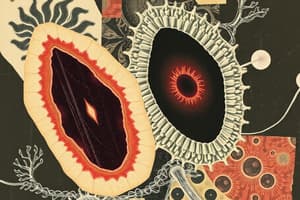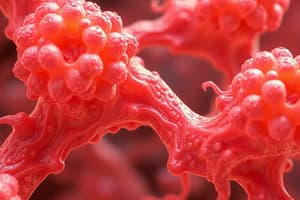Podcast
Questions and Answers
What type of substances can glandular epithelial cells synthesize?
What type of substances can glandular epithelial cells synthesize?
- Only hormones and enzymes
- Proteins, lipids, and complexes of carbohydrates and proteins (correct)
- Only carbohydrates and proteins
- Only proteins and lipids
How do glands develop from covering epithelia?
How do glands develop from covering epithelia?
- Epithelial cells differentiate into connective tissue cells
- Epithelial cells proliferate and remain at the surface
- Epithelial cells proliferate and penetrate connective tissue followed by further differentiation (correct)
- Epithelial cells die and are replaced by connective tissue cells
What is the functional part of a gland formed by its secretory cells called?
What is the functional part of a gland formed by its secretory cells called?
- Parenchyma (correct)
- Lobules
- Stroma
- Capsule
What type of glands release their products into the blood stream?
What type of glands release their products into the blood stream?
What surrounds a gland externally?
What surrounds a gland externally?
What divides the gland into lobes?
What divides the gland into lobes?
What is an example of a mixed gland?
What is an example of a mixed gland?
What term is used to describe the supporting elements of a gland?
What term is used to describe the supporting elements of a gland?
Which of the following glands is an example of a simple tubular gland?
Which of the following glands is an example of a simple tubular gland?
What type of secretion mechanism does the exocrine pancreas utilize?
What type of secretion mechanism does the exocrine pancreas utilize?
Which of the following glands produces a viscous, carbohydrate-rich secretion?
Which of the following glands produces a viscous, carbohydrate-rich secretion?
What is the difference between a simple gland and a compound gland?
What is the difference between a simple gland and a compound gland?
Which of the following glands is an example of a mixed gland?
Which of the following glands is an example of a mixed gland?
What type of secretion mechanism involves the loss of the entire secretory cell and its product?
What type of secretion mechanism involves the loss of the entire secretory cell and its product?
Which of the following glands is NOT an example of an exocrine gland?
Which of the following glands is NOT an example of an exocrine gland?
What is the main function of serous glands?
What is the main function of serous glands?
Flashcards are hidden until you start studying
Study Notes
Glandular Epithelium
- Glandular epithelial cells produce secretions, synthesizing, storing, and secreting proteins, lipids, and complexes of carbohydrates and proteins.
Development of Glands
- Glands form from covering epithelia through cell proliferation, penetration into connective tissue, and further differentiation.
- Glands may maintain contact with the surface, forming exocrine glands, or lose contact, forming endocrine glands.
General Histological Structure of Glands
- A gland is surrounded by a dense layer of connective tissue, forming a capsule, which extends into the gland, dividing it into lobes and lobules.
- The functional part of a gland, formed by its secretory cells, is known as the parenchyma, while the supporting elements, mainly connective tissue, are the stroma.
Classification of Glands
- Exocrine glands release products onto an epithelial surface, either directly or through a duct, e.g., salivary glands, mammary glands.
- Endocrine glands release products into the bloodstream, e.g., thyroid gland, pituitary gland.
- Mixed glands possess both exocrine and endocrine functions, e.g., pancreas, liver cells.
Histological Classification of Exocrine Glands
-
According to secretory mechanisms:
- Merocrine: secretory product is released by exocytosis, without loss of cell substance, e.g., pancreas, salivary glands.
- Apocrine: apical part of cytoplasm is lost with secretory product, e.g., female mammary gland.
- Holocrine: entire secretory cell and product are discharged, e.g., sebaceous glands.
-
According to duct system:
- Simple: ducts are not branched.
- Compound: ducts are branched.
-
According to secretory portion:
- Tubular: shaped like a tube, e.g., glands of intestine, stomach.
- Acinar or alveolar: flask-shaped with narrow centrally placed lumen, e.g., pancreas, parotid salivary gland.
- Tubuloacinar: combination of tube ends with sac-like dilatation, e.g., submandibular and sublingual salivary glands.
Histological Classification According to Nature of Secretions
- Mucous glands: produce viscid, slimy, carbohydrate-rich secretion, e.g., Pyloric glands of stomach.
- Serous glands: produce thin, watery, protein-rich secretions, often high in enzymatic activity, e.g., Exocrine pancreas, parotid salivary gland.
- Mixed glands: produce both mucous and serous secretions, e.g., sublingual and submandibular salivary glands.
Studying That Suits You
Use AI to generate personalized quizzes and flashcards to suit your learning preferences.




